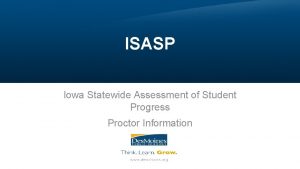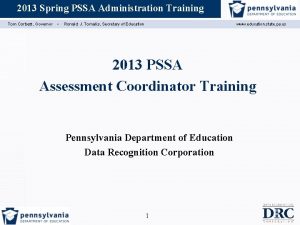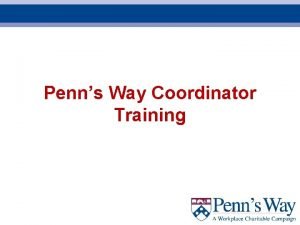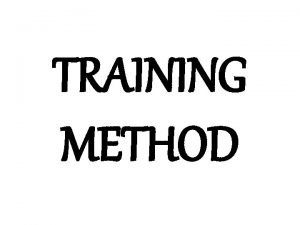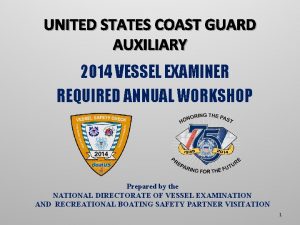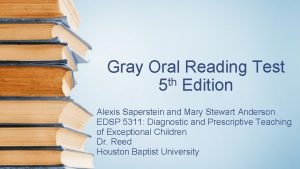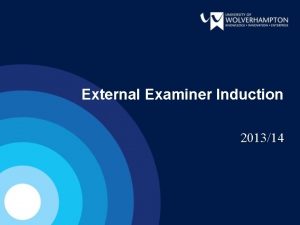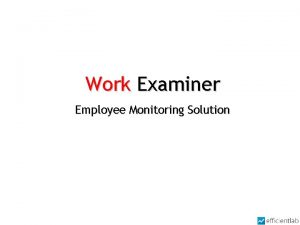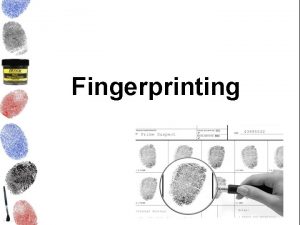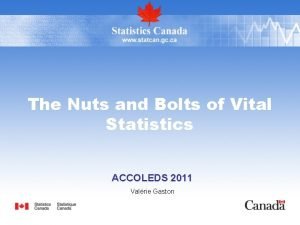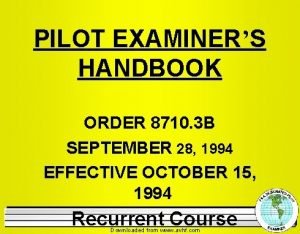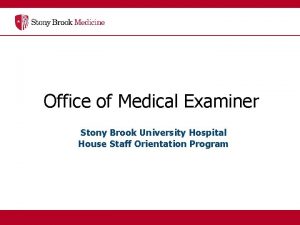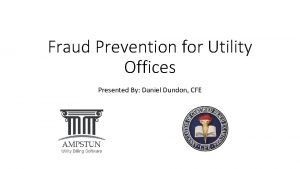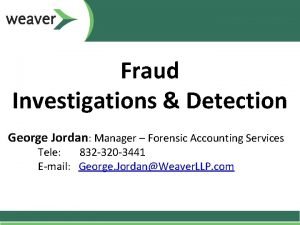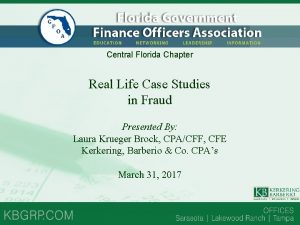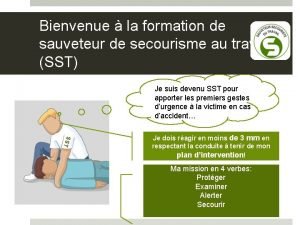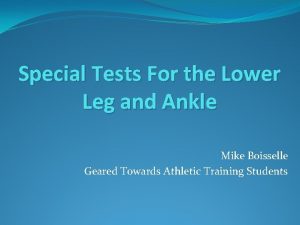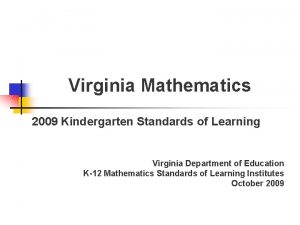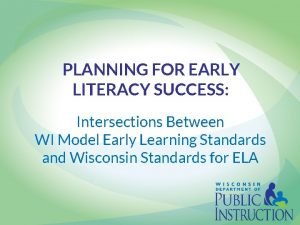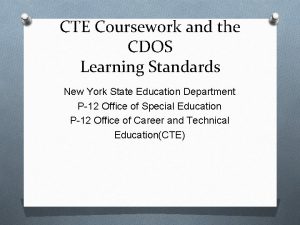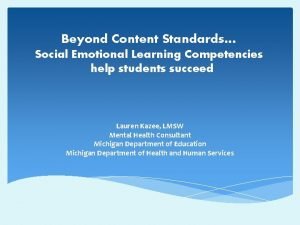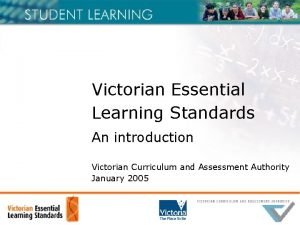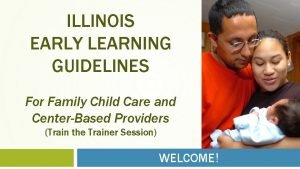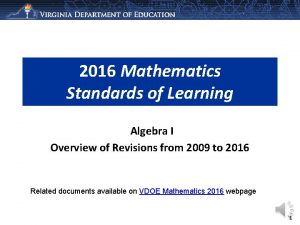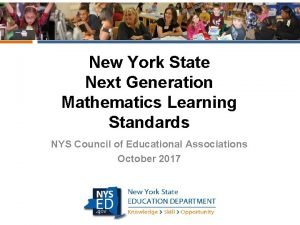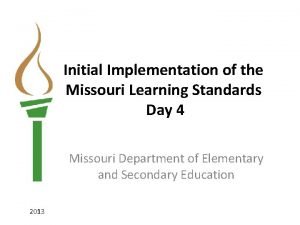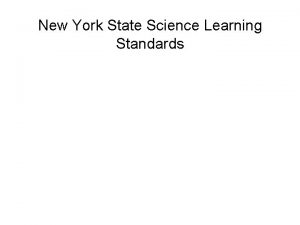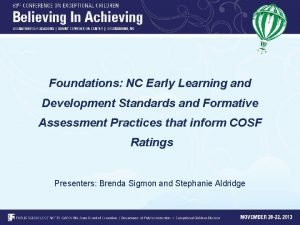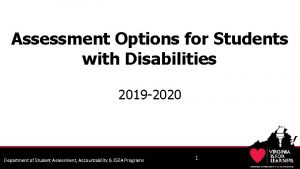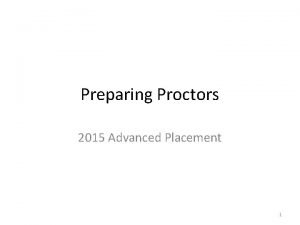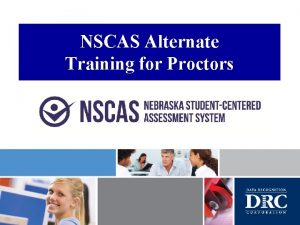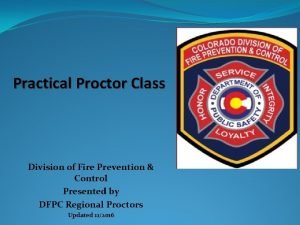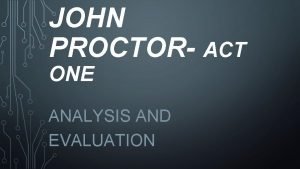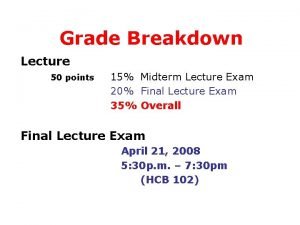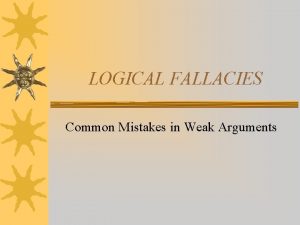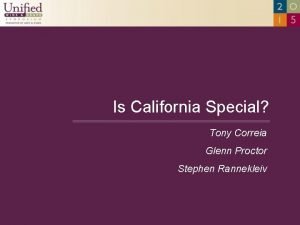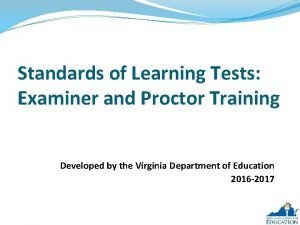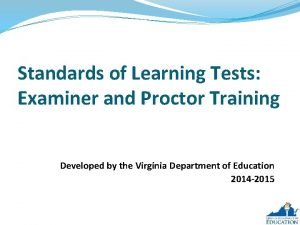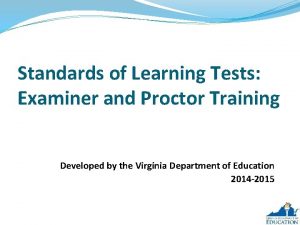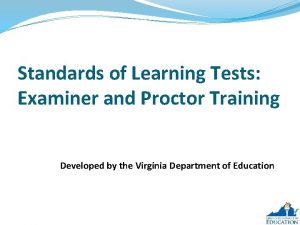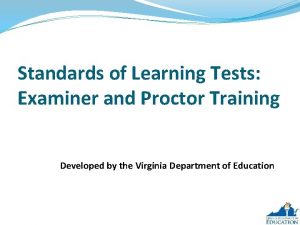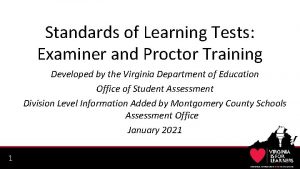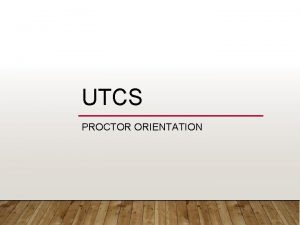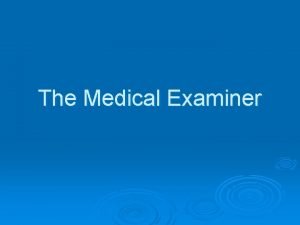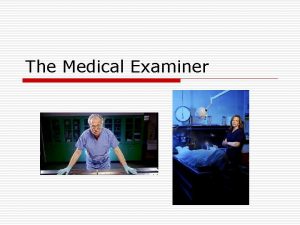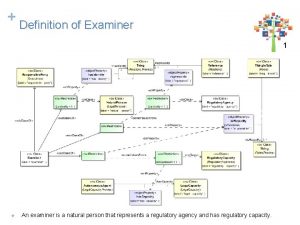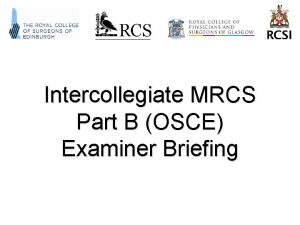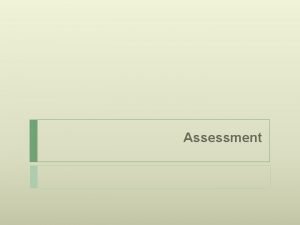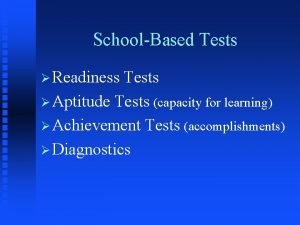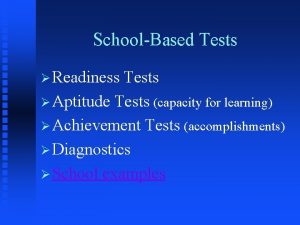Standards of Learning Tests Examiner Proctor Training DEVELOPED








































































- Slides: 72

Standards of Learning Tests Examiner & Proctor Training DEVELOPED BY THE VIRGINIA DEPARTMENT OF EDUCATION AND EDITED BY GREENE COUNTY PUBLIC SCHOOLS 2016 -2017

Examiners & Proctors v. This presentation is not meant to be the only document Test Examiners and Proctors use in preparing for your school’s testing. It is designed to be a guide. v. The Examiner’s Manual should be read in its entirety prior to testing. v. Any documents given to you by your STC (i. e. , Read Aloud Guidelines) should also be read prior to testing. v. All guidelines established by the Virginia Department of Education. 2

Examiners & Proctors v. What is the difference between an examiner and a proctor for Standards of Learning (SOL) testing? As defined in the Examiner’s Manual: A Test Examiner is responsible for administering the SOL tests according to the procedures outlined in the Examiner’s Manual and for maintaining securit 6 y of test materials 3

Examiners & Proctors As defined in the Examiner’s Manual: v. A Test Proctor works with the Test Examiner in administering the SOL tests and assists in maintaining an appropriate testing environment. v. A Test Proctor may be called upon to verify that: vthe test was administered according to the procedures outlined in the Examiner’s Manual vthe security of the test materials was maintained vstudents did not receive inappropriate assistance on the test v. The training expectations for SOL Test Examiners and Proctors are the same. 4

New Information SPRING 2016 5

New Information for 2016 Mathematics Computer Adaptive Tests (CAT) — Including Plain English, Audio, and Read Aloud v. Grade 3 v. Grade 6 v. Grade 7 v. Grade 8 v. A Computer Adaptive Test is an assessment that is customized for every student based on how the student responds to questions. v. The CAT adjusts the difficulty level of the questions from within the item pool for the test. 6

New Information for 2016 Mathematics Computer Adaptive Tests (CAT) — v. The CAT does not have a “Final Submit” button. v. The test is automatically submitted for the student after the last question has been answered. v. A student may not submit a test if it is not completed—all questions must be answered. 7

New Information for 2016 Grade 3 CAT — v. Consists of 32 questions and will be administered in one day. v. Exception—Students with disabilities who have multiple-day testing as an accommodation may take the test over two days. v. The test is broken into two sections with a “Stop” sign in between. 8

New Information for 2016 Grade 3 CAT — v. A seal code is not required between Section 1 and Section 2. v. Individual breaks may be given at this time. v. Group breaks are not permissible. v. The Test Examiner individually reads the directions to students as they finish Section 1. v. Calculators are not permitted in either Section 1 or in Section 2. v. Some multiple-choice and technology enhanced items (TEI) may have only 3 answer choices. v. Make students aware prior to the test. 9

New Information for 2016 Grades 6 & 7 CAT — v. Each test has two sections v. A Non-Calculator Section—occurs first v. A Calculator Section v. New icon so teachers and students have a visual that calculators are not allowed on this section of the test. 10

New Information for 2016 Grades 6 & 7 CAT — v. A screen with a stop sign appears between the non-calculator section and the calculator section. v. The Test Examiner assigns the scientific calculator to students. v. The Test Examiner individually reads the directions to students as they finish Section 1. v. New icon so teachers and students have a visual that calculators are not allowed on this section of the test. 11

New Information for 2016 Grades 6 & 7 CAT — v. A screen with a stop sign appears between the non-calculator section and the calculator section. v. The Test Examiner assigns the scientific calculator to students. v. The Test Examiner individually reads the directions to students as they finish Section 1. v. New icon so teachers and students have a visual that calculators are not allowed on this section of the test. 12

New Information for 2016 Grades 6 & 7 CAT — v. A screen with a stop sign appears between the non-calculator section and the calculator section. v. Indicates a calculator may be used on the remaining questions. v. The student is directed to raise his/her hand to receive a calculator. v. A checkbox is available for students to indicate they received a calculator. v. The Test Examiner assigns the scientific calculator to students. v. The Test Examiner individually reads the directions to students as they finish Section 1. NOTE: Students will not be able to proceed past this screen by hitting the Next button without entering a seal code and without checking the box. 13

New Information for 2016 Grades 6 & 7 CAT — 14

Continue in 2017 History Assessments— v. Spring 2016 tests will include: v. Field-test items based on content that is common between the 2008 and 2015 standards. v. Field-test items that are TEI v. Students must have the opportunity to practice the TEI prior to test day. v. Operational multiple-choice items assess only the 2008 standards. 15

Student Privacy Student Test Scores: Privacy — v. It was brought to the VDOE’s attention that in some schools, student confidentiality was not protected when providing SOL test results to students. v. This includes verbiage used when taking students out for remediation and testing after they failed the first administration of the SOL. v. This violates the Family Educational Rights and Privacy Act (FERPA). 16

Examiners’ Responsibilities and Activities: BEFORE TESTING 17

SOL Test Security All Test Examiners and Proctors must: v. Read the Virginia law regarding the consequences of violating test security procedures, including: v. Actions for violations of test security procedures (§ 22. 1– 19. 1) v. Violation of test security procedures: Revocation of license (§ 22. 1– 292. 1) v. Read, understand, and sign the School Division Personnel Test Security Agreement. Ask all questions before signing. Questions should be directed to the School Test Coordinator (STC). 18

SOL Test Security v. Some specific points form the School Division Personnel Test Security Agreement v. Security before, during, and after testing is of the utmost importance. v. Teachers/schools cannot require or put undue pressure on students to use a particular testing strategy during testing—this includes providing incentives. v. Points 2 and 10 on the School Division Personnel Test Security Agreement addresses this. 19

SOL Test Security v. Non-school employees should not be used as Test Examines or Proctors. They should not come in contact with the test in any way. v. Student teachers v. Interns v. Volunteers v. Substitutes 20

SOL Test Security: Electronic Devices v. Students may not access any electronic device, including but not limited to cell phones, e-books, tablets, games, “Smart” watches, etc. during SOL testing. 21

SOL Test Security: Cheating Any incident in which a student is suspected of cheating must be reported immediately to your STC. 22

Manuals for Test Administration v. Test Examiners and Proctors will be provided with your own copies of the appropriate manual(s). This could include: v. Examiner’s Manual for each test being administered v. Supplement to the Examiner’s Manual (for the administration of paper tests) v. Guidelines for Administering the Read Aloud Accommodation for Standards of Learning Assessments (if the Read-Aloud form of a test is being administered) 23

Manuals for Test Administration v. Test Examiners and Proctors are expected to read each manual that pertains to the test being administered prior to the day of testing. v. Read each manual early so that ample time is available to ask the STC all questions that arise. v. Test Examiners and Proctors are encouraged to “mark-up” your manuals in order to deliver the directions to the students in the clearest possible way. v. Regardless of a Test Examiner’s or Proctor’s previous experience with SOL testing, there is no substitute for reading the manuals—procedures frequently change. 24

Prepare the Students v. Prepare your students for testing using the Practice Items on the VDOE website. v. The day of the test should not be the first time a student uses Test. Nav and its tools. v. The day before testing, remind students to: v. Get a good night’s rest v. Eat a good breakfast v. Remind them no electronic devices are allowed during the test 25

Secure Test Materials v. Know the process for receiving secure testing materials from your STC. Counting and checking that you have all required materials takes time, so plan accordingly. v. Secure testing materials includes test tickets and/or test booklets. v. Test Examiners must count all secure testing materials issued—in front of the STC. v. Test Examiners must sign a transmittal form after verifying the amount of secure materials received. v. If there is a discrepancy between what is listed on the transmittal form and what the Test Examiner counts, adjustments must be made prior to signing the transmittal form. 26

Non-Secure Test Materials v. Non-secure test materials are listed in each Examiner’s Manual and vary by test. Examples may include unused scratch paper, pencil or pen, calculator, etc. v. All scratch paper becomes secure when it is handed out to students and must be accounted for. v. Know what you should expect to receive for the student(s) you are responsible for testing. v. Know how many sheets of paper you give them and have them write their name on each page. 27

Test Materials: Calculators v. If you will administer a test for which students are allowed a hand -held calculator, know whether the school or student will supply the calculator. v. The Examiner’s Manuals list those tests that permit a hand-held calculator and the state-approved calculators for each test. v. Calculators must be prepared following the guidelines in the Examiner’s Manual prior to testing. Guidelines include directions for clearing memory and lists allowable applications for specific calculator models. 28

Test Materials: Calculators v. For the Grades 4, 5, 6, and 7 Mathematics tests, the stateapproved hand-held calculator is distributed to students ONLY upon entering Section 2 of the test. v. Student access to a calculator during Section 1 or not having access to a calculator during Section 2 of these tests is a testing irregularity and must immediately be reported to the STC. 29

Test Site Preparation v. Remove or cover all curricular materials related to test content and test-taking strategies that might influence student performance or provide an unfair advantage to students. These materials include but are not limited to: Class Notes Study Guides Maps Timelines Graphic organizers Charts Posters Projections Computer programs Textbooks Dry-erase board displays Chalk board displays Bulletin board displays Word walls 30

Test Site Preparation v. Placing physical barriers, free of any writing or graphics between workstations is helpful in preventing students from viewing each other’s computer monitors. v. Testing rooms should be quiet, well lighted, and well ventilated. Report problems to the STC. v. Each student’s work space should be clear of books and other materials not required for the test and large enough to accommodate required testing materials. v. Plan appropriately for overcrowding. 31

Test Site Preparation v. Seating should be arranged to discourage students from viewing or copying one another’s work and from communicating with one another during testing. v. Students must not have access to cell phones or other devices that are capable of providing an advantage. 32

Accommodations for Students v. Test Examiners and Proctors should be familiar with any special testing accommodations required for each student in the testing group prior to the day of testing. v. For many students, special testing accommodations vary by test. v. It is important to provide accommodations needed for the specific test being administered each day. 33

Accommodations for Students v. Coordinator with the STC how special test accommodations will be provided to students in the testing group. v. One-on-one testing v. Small-group testing v. Included in the regular classroom v. Descriptions of special test accommodations are included in each Examiner’s Manual. 34

School Testing Schedule v. Test Examiners should be aware of the overall testing schedule in your building. v. Based on the schedule in your school, Test Examiners should review the procedures outlined in the Examiner’s Manual. v. Breaks that are student initiated v. One- or two-day testing 35

Procedures for Contacting the STC v. Know the procedures for contacting the STC during testing. v. The STC will describe the procedure and provide examples of situations for which s/he should be contacted. 36

Remember… v. Read all manuals issued to you. v. Ask questions before the morning of testing if at all possible. v. If you are unsure of any policies and/or procedures, ask the STC for guidance. v. If you are unsure how to handle a situation that arises during testing, stop and ask the STC for guidance rather than allowing the student(s) to continue testing. There is no substitute for Reading the manuals. 37

Examiners’ Responsibilities and Activities: DURING TESTING 38

Contacting the STC v. If a situation occurs in which you must contact the STC during testing, the integrity of the testing environment must be maintained in order for testing to continue. v. If you are unsure how to handle a situation that arises during testing, stop and ask the STC for guidance rather than allowing student(s) to continue testing. 39

Test Site Preparation v. To help prevent irregularities, carefully check the test room on the day of testing before distributing any test materials to students. v. Do not assume the test sites are ready, including rooms used for extended testing. v. Ensure the test site is ready for testing, even if the room was used previously to administer tests to students. v. Ensure all rooms used for testing have been properly prepared so that testtaking strategies and content information are not visible. v. It may be helpful to place a “Testing: DO NOT DISTURB” sign on the door. 40

Test Site Preparation v. Arrange seating to discourage students from viewing or copying one another’s work and from communicating with one another. v. Test Examiners and Proctors must ensure students do not have access to unauthorized materials within the room or in desks. v. Make sure all desks/workstations are clear of all materials not needed/authorized for testing. v. Have students place book bags and other materials away from the desks/workstations. If they are in the room, they should be placed at the front of the room. v. Make sure students do not have access to cell phones or other electronic devices. 41

Preparing Workstations for Testing and Monitoring Students v. Test Examiners and Proctors are responsible for preparing computers for testing the morning of the test. v. Your STC will give you a handout on the procedures and computer testing login for your school. 42

Getting Started v. If the test is an audio or read aloud administration, look for the appropriate icons on the student test ticket. v. Audio – will not start until after the sample problems v. Read Aloud v. Be sure students receive their own test ticket. v. Watch for students with similar names or siblings. v. Students should sign their name on the test ticket. v. Students should check to be sure that it is their name on the screen after they log into Test. Nav. 43

Getting Started v. Read the directions for students (in bold type) from the Examiner’s Manual exactly as written. v. If a mistake is made in reading a direction, use the verbiage provided in the Examiner’s Manual, then read the direction again. v. Unless otherwise noted in the “Troubleshooting” section of the Examiner’s Manual, Test Examiners and Proctors must not touch a student’s mouse, keyboard, or computer screen. v. Problems with technology must be reported to the STC. v. No one, besides the student, must ever use a student’s test ticket to log into Test. Nav for any reasons. 44

Distributing Test Materials v. Distribute test materials exactly as prescribed in the Examiner’s Manual. v. All materials must be distributed directly by the Test Examiner to each individual student. v. Test Examiners and Proctors must never have students pass testing materials, scratch paper, etc. , to each other. 45

Absent Students v. Follow the process established by your school to report absent students to the STC. v. Write “Absent” at the top of the test ticket. v. Put absent students’ test tickets on top of the test tickets when turning them in to the STC. 46

Accommodations for Students v. If, on the day of testing, a Test Examiner or Proctor is unsure about a student’s special testing accommodations, the Test Examiner and/or Proctor should seek clarification from the STC before the student begins testing. v. Specific information regarding special testing accommodations is located in Appendices B & C of the Examiner’s Manuals. v. Test Examiners and Proctors administering a read-aloud assessment must consult the Guidelines for Administering the Read-Aloud Accommodations for Standards of Learning Assessments and list to an audio Practice Test in the subject on the VDOE website. 47

Accommodations for Students v. Student Authorization Tickets for online Audio and Read-Aloud tests will have an icon indicating the test format: v Indicates an Audio test form v Indicates a Read-Aloud test form v. Test Examiners/Proctors need to check that the appropriate icon appears on the Student Authorization Ticket(s) for students who should be assigned an Audio or Read-Aloud form. v. Remember………… You will not hear audio until after the sample questions. v. If a student needs to be flipped to either an audio/read aloud or nonaudio/non-read aloud form, have the student in Exited Status prior to calling the STC 48

Irregularities v. A testing irregularity is anything that occurs while a student is testing that: v. Inappropriately influences student performance v. Inappropriately influences the reporting of student performance v. Constitutes a breach in test security v. Results in the improper implementation of mandatory student testing v. ALL testing irregularities must be reported immediately to the STC. 49

Irregularities v. Test Examiners and Proctors must know the school and division’s protocol for reporting testing irregularities: v. Test Examiners and Proctors will report all irregularities to the STC immediately. v. The STC will report all irregularities immediately via telephone to the DDOT. v. All testing irregularities must be documented in writing and forwarded to the DDOT within 24 hours of the occurrence. v. Test Examiners and Proctors may use the Test Irregularity Form in the Examiner’s Manual to document the irregularity. v. Follow-up information may be requested by the DDOT or the VDOE. 50

Irregularities v. Examples of testing irregularities are included in the Examiner’s Manuals. Examples of test irregularities include, but are not limited to: v. A student becomes ill or has to leave for an appointment during testing and cannot finish the test v. A student leaves the test setting without an escort or monitor v. A student access an electronic device in the testing room v. A student is observed cheating during the test v. An adult provides inappropriate assistance to a student during testing v. A student is provided with an inappropriate manipulative (e. g. , calculator) during testing v. An unused test ticket is missing 51

Monitoring Test Sessions v. Once students and the Test Examiner enter the testing room, all instruction and/or review of the content covered by the test or discussion of testing strategies must stop. v. Monitor test sessions by moving as unobtrusively as possible about the room and ensure that students are working independently. v. Off Seat/On Feet 52

Monitoring Test Sessions v. Test Examiners and Proctors must not engage in any activities that interfere with monitoring testing. Such activities include, but are not limited to: v. Reading v. Grading papers v. Using electronic devices v. Working/playing on the computer/tablet/cell phone v. Talking to a friend v. Etc. 53

Monitoring Test Sessions v. Test Examiners and Proctors must not : v. Read test items v. Copy test items v. Take notes about the test v. Record student responses to test items v. Discuss the test items or test content with anyone during or after the test session v. Test Examiners and Proctors must not help students on any test item. 54

Monitoring Test Sessions v. Test Examiners and Proctors must not : v. Leave students or test materials unattended for any reason or length of time v. TEST EXAMINERS MUST BE IN THE ROOM AT ALL TIMES—NOT IN THE HALLWAY, NOT STANDING IN THE DOORWAY, NOT IN THE ROOM NEXT DOOR v. Allow students to have access to any electronic devices v. Allow students to have access to any unauthorized materials 55

Answering Student Questions v. The Examiner’s Manuals provide directions for how to handle student questions that arise during testing. v. Follow the directions related to student questions in the Examiner’s Manuals exactly as written. v. Test Examiners and Proctors must never read test questions. Reading a test question is a violation of test security. 56

Reporting Errors v. If a student reports an error in a test question and/or answer choices, the Test Examiner/Proctor must not read the test question. Instead, record the following information: v. Name of the student v. Subject area test and test level v. Question number v. A brief statement of the student’s concern v. Tell the student that the concerns will be reported. v. Notify the STC of the student’s concern, and the STC will notify the Division Director of Testing (DDOT). 57

Reporting Errors v. Do not communicate information related to the test questions and/or answer choices through electronic mail or in any other manner that will jeopardize the security of the test item. 58

Technical Issues During Testing v. If a technical issue arises during testing, CONTACT YOUR STC IMMEDIATELY. S/HE WILL THEN CONTACT THE DDOT—IN ALL SITUATIONS. v. An incident that you think is incidental may in fact be a testing irregularity. v. If a technical issue impacts a student’s test: v. Keep the student in the secure testing environment under testing conditions while awaiting assistance. v. Refer to the Troubleshooting section of the Examiner’s Manual for directions regarding frequently encountered online test scenarios. v. AGAIN—the STC needs to be contacted immediately. 59

Extended Testing v. SOL tests are untimed but must be completed within one school day. v. Students who have not completed their tests at the end of the allotted time should be given additional time to finish and may be moved to an alternate location. v. When moving to an alternate location, students must be constantly and carefully monitored. Students must not: v. Have access to any content materials or electronic devices v. Interact with other students or discuss the test or course content in any way with anyone—including other students and teachers. 60

Extended Testing v. Students’ test materials (including all test tickets, test booklets, scratch paper, test manipulatives) must be carried by school personnel who are trained in test security from the original test site to the alternate location. v. The school must establish and follow procedures that ensure all materials are accounted for each time materials are transferred from one adult to the next. 61

Emergency Procedures v. If an emergency occurs, the safety of students and the Test Examiner/Proctor is the first priority. The second priority is to secure test materials and student responses. v. Since emergency drills are not to be conducted during testing, any emergency notification should be considered “real. ” v. Stay calm and follow the safety procedures established by your school and provided by your STC. v. The VDOE will determine the next steps for testing after receiving information from the DDOT regarding the emergency. v. Students should not resume testing until instructed to do so by the STC. 62

Emergency Procedures v. The DDOT will provide VDOE information related to the emergency. v. Security of the test site v. Were test rooms locked? v. Did anyone access the room after the Test Examiner and students left? v. Security of test materials v. Were tests exited and/or computers shut down? v. Has the Test Examiner accounted for all test materials? 63

Emergency Procedures v. Security of the test environment for students v. Did students interact? v. Did students have access to electronic devices? v. Did students have access to curricular materials/testing strategies? v. Did students remain under direct supervision of the Test Examiner and/or Proctor? v. Time remaining to complete testing v. At the conclusion of the emergency, students must remain quiet and cannot communicate with one another while you await further instructions from the STC. v. VDOE will determine the next steps for testing after receiving information from the DDOT regarding the emergency. 64

Examiners’ Responsibilities and Activities: AFTER TESTING 65

Collecting Test Materials v. Collect test materials from each student as they complete the test according to directions in the Examiner’s Manual. v. Collecting and accounting for all materials distributed to each student is imperative. v. Once scratch paper has been distributed to students during testing, it is considered secure test material. v. All scratch paper, used and unused, that was distributed to students must be collected from individual students and returned to the STC. 66

Returning Test Materials v. The STC will count all test materials returned by the Test Examiner—in your presence, verify the counts match the transmittal form, and initial the transmittal form. v. The Test Examiner will sign the Examiner’s/Proctor’s Affidavit. v. All test materials must be transferred to the next location (test site for extended testing or secure testing materials storage room) by an adult who counts the materials and maintains the security of the materials during transfer. v. Do not discuss the test at anytime with anyone. v. Discussing the test or any test content is a violation of the School Division Personnel Test Security Agreement. 67

Examiners’ Responsibilities and Activities: TROUBLESHOOTING 68

Troubleshooting v. Do not bypass the STC as your primary point of contact in all situations. v. Please report all irregularities—failing to report an irregularity can be far more serious than the irregularity itself. 69

Troubleshooting v. Audio and Read Aloud v. Be sure the student is in Exit status prior to calling the STC. v. Keep the student seated at the workstation. v. Student submits test prematurely v. The student must stay in the room seated at his/her workstation. v. Call the STC. 70

Reminders v. Read all applicable manuals prior to testing. v. If at all possible, ask questions prior to the first day of testing. This helps testing days run smoothly. v. Report any situations which could be potential test irregularities to your STC as soon as they occur. v. Testing logins are confidential—students are never to log into the computer using the testing login. 71

References v. Examiner’s Manual v. Virginia Department of Education Testing Site – http: //www. doe. virginia. gov/testing/sol/ 72
 Ace different tests iq but make
Ace different tests iq but make Isasp manual
Isasp manual Pssa sac training
Pssa sac training Pssa proctor training
Pssa proctor training Disadvantages of circuit training
Disadvantages of circuit training Vessel examiner test answers
Vessel examiner test answers Medical examiner vs coroner
Medical examiner vs coroner Peeee paragraph
Peeee paragraph Gort-5 sample report
Gort-5 sample report Attendance certificate for external examiner
Attendance certificate for external examiner Medical examiner vs coroner
Medical examiner vs coroner Eduqas english literature past papers
Eduqas english literature past papers Work examiner review
Work examiner review Dr stephen evans ottawa
Dr stephen evans ottawa The study of fingerprint identification is called
The study of fingerprint identification is called Nc medical examiner and coroner guidelines
Nc medical examiner and coroner guidelines Kansas assessment program
Kansas assessment program Accoleds
Accoleds Flight examiner handbook
Flight examiner handbook Medical examiner
Medical examiner Kevin horn medical examiner
Kevin horn medical examiner Certified fraud examiner
Certified fraud examiner Texas theft value ladder
Texas theft value ladder Jerry l. crundwell
Jerry l. crundwell Pictogramme sst examiner
Pictogramme sst examiner Ankle special tests athletic training
Ankle special tests athletic training Cuadro comparativo de e-learning b-learning y m-learning
Cuadro comparativo de e-learning b-learning y m-learning Customer service standards table
Customer service standards table 2009 mathematics standards of learning answers
2009 mathematics standards of learning answers Wmels performance standards
Wmels performance standards Nys cte standards
Nys cte standards Social emotional learning standards michigan
Social emotional learning standards michigan Victorian essential learning standards
Victorian essential learning standards Social emotional learning standards nj
Social emotional learning standards nj Idoe mtss
Idoe mtss Illinois early learning standards
Illinois early learning standards Social emotional learning washington state
Social emotional learning washington state 2016 algebra 1 sol
2016 algebra 1 sol 2017 english standards of learning curriculum framework
2017 english standards of learning curriculum framework 2016 mathematics standards of learning
2016 mathematics standards of learning Next generation math standards grade 2
Next generation math standards grade 2 How to write missouri learning standards
How to write missouri learning standards New york state standards science
New york state standards science Nc early learning standards
Nc early learning standards Vaap manual
Vaap manual Sol proctor
Sol proctor Why did mrs. putnam send her daughter to tituba
Why did mrs. putnam send her daughter to tituba To what does john proctor convince mary warren to testify?
To what does john proctor convince mary warren to testify? John proctor iii
John proctor iii The crucible final test review
The crucible final test review Francis nurse the crucible character traits
Francis nurse the crucible character traits Sol proctor
Sol proctor Ap exam proctor ratio
Ap exam proctor ratio Nscas growth proctor guide
Nscas growth proctor guide John proctor fbi
John proctor fbi Is elizabeth proctor pregnant
Is elizabeth proctor pregnant John proctor act 1 quotes
John proctor act 1 quotes The crucible character chart act 1
The crucible character chart act 1 Proctor medical equipment
Proctor medical equipment The crucible elizabeth proctor quotes
The crucible elizabeth proctor quotes Ad hominem fallacy
Ad hominem fallacy How does john hale show his disapproval
How does john hale show his disapproval Why does hale visit the proctor's’ home
Why does hale visit the proctor's’ home Proctor fire extinguisher
Proctor fire extinguisher Elizabeth proctor age
Elizabeth proctor age Social class in the crucible
Social class in the crucible How did john proctor redeem himself
How did john proctor redeem himself Shemin proctor
Shemin proctor What is a proctor
What is a proctor The crucible character traits
The crucible character traits Ralph r. proctor
Ralph r. proctor Post hoc ergo proctor hoc
Post hoc ergo proctor hoc Glenn proctor
Glenn proctor

